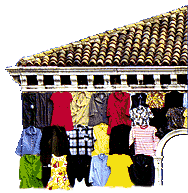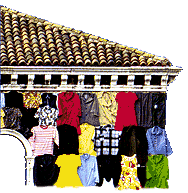
Clothes
for History:
an Attempt to Tell
Dario Pinton
School of the "Varoteri" from the Latin varium, varied, speckled and spotted just like the grey fur which once was used for the clothes of judges and dignitaries, varium, as it was called.
Varoteri that is furrers.
The building of the School stands out as an eccentric one with respect to the rest of Venetian architecture, alone in the space of Campo Santa Margherita as a theatrical object on the town scene. Rather than conveying an idea of solidity which accompanies all architecture, Venetian buildings one next to the other give the impression of standing in front of a pictorial surface, similar to painted canvas. Just because of its isolation the architectural body of the School gives, as an opposite, the impression of being a sculpture, a plastic object.
Schools in Italian confraternite (confraternities) of Medieval origin were either lay associations with devotional purposes and associations of crafts and arts. Many of these owned a building called "School" as well which constituted the social headquarters of the organization, whereas more modest ones simply possessed an altar in a church.
A complex phenomenon, Schools unified in themselves dimensional, charitable, political, social, architectural and artistic aspect. The presence of the Schools in the social and urban texture of Venice was massive and it testified a vitality which crossed the frontiers of trade and devotion. The architectural typology proposed a Ceremonial Room at the ground floor, at the upper floor the Capitular Room for the meetings , communicating with a smaller one called albergo where precious properties owned by the School were kept and the members of the government would meet.
The rooms were often decorated with paintings usually illustrating the life and the miracles of the patron saint.
The School of the Varoteri has not been isolated and in Campo Santa Margherita from its birth. The first seat was at the Crociferi, now Gesuiti, in the Sestiere (quarter) of Cannaregio until it was moved, in 1725, to the present seat built on the bank of a now filled-in canal.
Campo Santa Margherita as it is now, with no direct overture on the canal, in the past was bordered by a canal communicating with San Barnaba's canal by means of two arms. These two are now called Rio Terà Canal and Rio Terà della Scoazzera. The Scoazzere where "an encircled square of wall, with no roof and open in the front, where rubbish scoazze in the vernacular expression was collected until the burchieri o burchiellanti (the conductors of the city boats) would bring them out of the town" (translated from Tassini, Curiosità Veneziane, Venice, Ed. Filippi, 1933).
On the canal's bank arose this edifice, separated from the houses since it was probably a leather depot as well, and it must not have diffused a pleasant smell and the leather could be transported on boats.
When in 1725, the new edifice of the School in Campo Santa Margherita was built, the Varoteri wanted it to be exactly like the ancient place demolished at the Crociferi. The reconstruction did not follow the contemporary taste but re-proposed the ancient building with its form, through the setting in the façade of the old relief of the Virgin Mary with the infant Jesus venerated by the brothers and re-using the fluted capitals on the small pilasters at the basis of the windows arch. After 1810 the building was made a coal yard, then it hosted a "School of fascist mysticism" hence the popular denomination casa del boia (house of the executor) and finally the headquarter of a political party. Now city offices are finding their place there.
Besides the typical conservative spirit of part of the Venetian society which invites us to see the School as a bulwark of the resistance against the diachronic transformations we have in the Varoteri's building the visible, concrete store of memory. To remember facts, things means trying to establish a relationship between what once were and what is now, the thread of memory unites the appearance of things by means of echoes and analogies; it creates textures, mental habits, dresses for history which may show possible routes, liveable stories. To keep things or words together in a narrative is making sense, say repeating what we saw and which happened to us. "And all we can do is call things and let them come to us with their tales. Call them to prevent them from becoming so alien that they'll be leaving, each one on its own, in the different directions of the universe, leaving us here, incapable to understand a trace to map by. I call the things to keep them with me to the last" (translation from G. Celati, Verso la foce, Milan, Feltrinelli, 1989).
